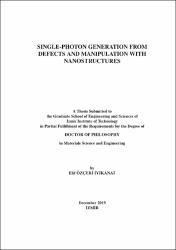Please use this identifier to cite or link to this item:
https://hdl.handle.net/11147/9635Full metadata record
| DC Field | Value | Language |
|---|---|---|
| dc.contributor.advisor | Tarhan, Enver | |
| dc.contributor.advisor | Aygün Özyüzer, Gülnur | |
| dc.contributor.author | Özçeri İyikanat, Elif | - |
| dc.date.accessioned | 2020-08-27T08:17:13Z | |
| dc.date.available | 2020-08-27T08:17:13Z | |
| dc.date.issued | 2019-12 | en_US |
| dc.identifier.citation | Özçeri İyikanat, E. (2019). Single-photon generation from defects and manipulation with nanostructures. Unpublished doctoral dissertation, Izmir Institute of Technology, Izmir, Turkey | en_US |
| dc.identifier.uri | https://hdl.handle.net/11147/9635 | |
| dc.description | Thesis (Doctoral)--Izmir Institute of Technology, Materials Science and Engineering, Izmir, 2019 | en_US |
| dc.description | Includes bibliographical references (leaves: 146-159) | en_US |
| dc.description | Text in English; Abstract: Turkish and English | en_US |
| dc.description.abstract | Single-photon sources are essential components for several applications in the field of quantum information technologies, such as quantum cryptology and quantum computation. To this aim, efficient generation and detection of single-photons are the crucial to be achieved. Among single-photon sources that are extensively studied in the literature, defect centers in solid are very promising due to their room temperature operation and their stability. The aim of this thesis is to generate single photons at room temperature and control their optical properties by nanostructures. Single-photon emission from TMDCs originates from localized weakly bound excitons at cryogenic temperatures due to their small exciton binding energies. However, room temperature SP emission from WS2 can be obtained by creatingWO3 defects. In our study, room temperature emission from defects in WO3 was investigated. Density functional theory calculations showed that the source of the emission can be oxygen defects. Additionally, the emission was brightened by plasmonic gold nanoparticles. Furthermore, defects in two-dimensional (2D) hexagonal boron nitride (hBN) is offered as an efficient room temperature SPS. HBN is a wide bandgap 2D material, in which defect centers create discrete energy level to generate single photons. In our study, reversible single-photon emission control from defects in hBN was demonstrated by Förster-like resonance energy transfer between the single-photon emitter and a graphene layer. To this aim an ionic liquid based device structure was used. | en_US |
| dc.description.abstract | Tek-foton kaynakları, kuantum kriptolojisi ve kuantum hesaplama gibi kuantum bilgi teknolojileri alanındaki çeşitli uygulamalar için temel bileşendir. Bu amaçla, tekfotonların verimli bir şekilde üretilmesi ve tespit edilmesi çok önemlidir. Literatürde yoğun olarak incelenen tek-foton kaynakları arasında, katı ortamlardaki kusur merkezleri, oda sıcaklığındaki çalışmaları ve stabiliteleri nedeniyle oldukça ümit vericidir. Bu tezin amacı oda sıcaklığında tek-foton üretmek ve optik özelliklerini nanoyapılarla kontrol etmektir. TMDC’lerden lokalize zayıf bağlanmış eksitonlardan kaynaklanan tek-foton emisyonu düşük eksiton bağlanma enerjileri nedeniyle krayojenik sıcaklıklarda gözlenir. Bununla birlikte, WS2’den oda sıcaklığında tek-foton emisyonu, WO3 kusurları yaratılarak elde edilebilir. Çalışmamızda, WO3’teki kusurlardan oda sıcaklığı emisyonu incelenmiştir. Yoğunluk fonksiyonel teorisi hesaplamaları, emisyon kaynağının oksijen kusuru olabileceğini göstermiştir. Ek olarak, emisyon şiddeti plazmonik altın nanoparçacıkları ile arttırıldığı gösterilmiştir. Ayrıca, iki boyutlu altıgen bor nitrürdeki (hBN) kusurlar, verimli bir oda sıcaklığı tek-foton kaynağıdır. HBN, kusur merkezlerinin tek-foton üretmek için kesikli enerji seviyesi oluşturduğu geniş bir bant aralığına sahip bir malzemedir. Çalışmamızda, hBN’deki kusurlardan tersinir olarak tek-foton ışıması kontrolü, kaynak ile bir grafen katmanı arasındaki Förster benzeri rezonans enerji transferi ile gösterilmiştir. Bu amaçla iyonik sıvı bazlı bir cihaz yapısı kullanılmıştır. | en_US |
| dc.format.extent | xx, 159 leaves | en_US |
| dc.language.iso | en | en_US |
| dc.publisher | Izmir Institute of Technology | en_US |
| dc.rights | info:eu-repo/semantics/openAccess | en_US |
| dc.subject | Single-photon | en_US |
| dc.subject | Nanostructures | en_US |
| dc.subject | Graphene | en_US |
| dc.subject | Quantum dots | en_US |
| dc.subject | Quantum information technologies | en_US |
| dc.title | Single-photon generation from defects and manipulation with nanostructures | en_US |
| dc.title.alternative | Kusurlardan tek-foton üretimi ve nanoyapılarla manipülasyonu | en_US |
| dc.type | Doctoral Thesis | en_US |
| dc.institutionauthor | Özçeri İyikanat, Elif | - |
| dc.department | Thesis (Doctoral)--İzmir Institute of Technology, Materials Science and Engineering | en_US |
| dc.relation.publicationcategory | Tez | en_US |
| item.languageiso639-1 | en | - |
| item.fulltext | With Fulltext | - |
| item.openairecristype | http://purl.org/coar/resource_type/c_18cf | - |
| item.openairetype | Doctoral Thesis | - |
| item.grantfulltext | open | - |
| item.cerifentitytype | Publications | - |
| Appears in Collections: | Phd Degree / Doktora | |
Files in This Item:
| File | Description | Size | Format | |
|---|---|---|---|---|
| 10319049.pdf | DoctoralThesis | 26.84 MB | Adobe PDF |  View/Open |
CORE Recommender
Page view(s)
286
checked on Jul 22, 2024
Download(s)
316
checked on Jul 22, 2024
Google ScholarTM
Check
Items in GCRIS Repository are protected by copyright, with all rights reserved, unless otherwise indicated.